Stable coins are revolutionizing the way migrants send remittances by providing a cost-effective, fast, and accessible solution for cross-border transactions. By being pegged to stable assets, these digital currencies minimize volatility and ensure that funds retain their value, making them a reliable option for transferring money. Popular choices like USDC, DAI, and Tether (USDT) are favored for their low fees and quick processing times, enhancing the remittance experience for users worldwide.
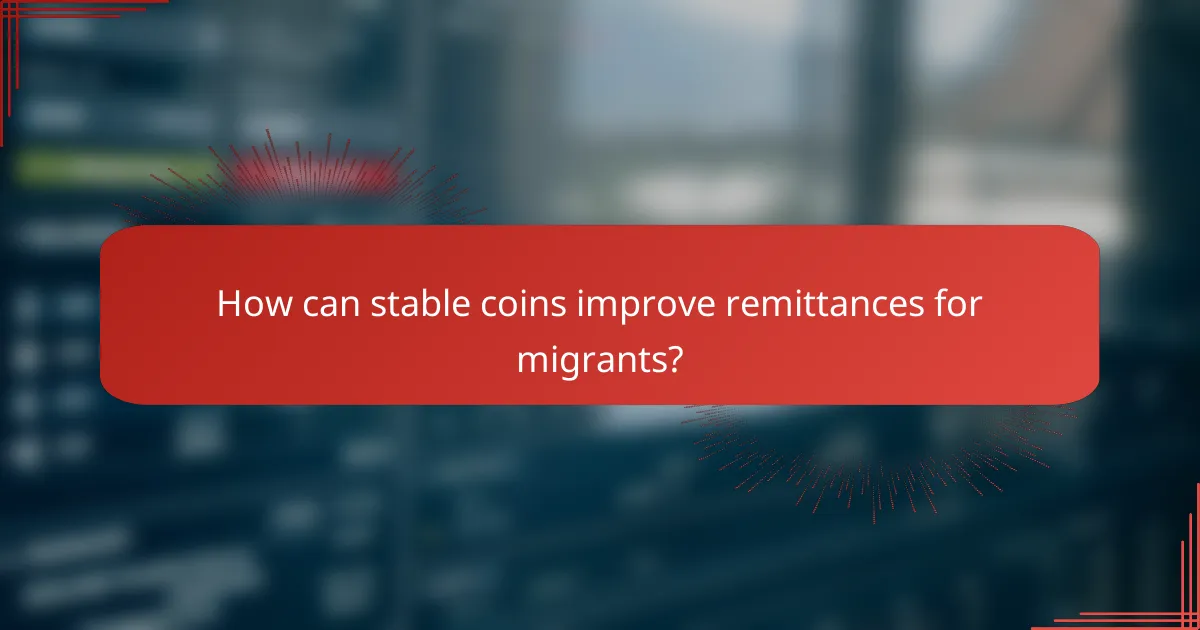
How can stable coins improve remittances for migrants?
Stable coins can significantly enhance remittances for migrants by offering lower costs, quicker transfers, and broader access to financial services. These digital currencies, pegged to stable assets, mitigate volatility and streamline the process of sending money across borders.
Lower transaction fees
One of the primary advantages of using stable coins for remittances is the reduction in transaction fees. Traditional remittance services often charge fees that can range from 5% to 10% of the transfer amount, while stable coin transactions typically incur fees of less than 1%. This means more of the money sent home reaches the intended recipient.
Additionally, stable coins eliminate the need for intermediaries, which further reduces costs. Migrants can save significant amounts over time, allowing them to send larger sums or support their families more effectively.
Faster transfer times
Stable coins facilitate near-instantaneous transfers, often completing transactions within minutes. In contrast, traditional remittance methods can take several days to process, especially when involving banks or currency exchanges. This speed is crucial for migrants who need to send money quickly for emergencies or urgent expenses.
The efficiency of blockchain technology, which underpins stable coins, allows for real-time settlement without the delays associated with traditional banking systems. This immediacy can provide peace of mind for both senders and recipients.
Increased accessibility
Stable coins enhance accessibility to financial services for migrants, particularly those in regions with limited banking infrastructure. Many individuals can access stable coin wallets via smartphones, enabling them to send and receive money without needing a traditional bank account.
This increased accessibility is vital for migrants who may face barriers to conventional banking, such as high fees or lack of identification. By using stable coins, they can participate in the global economy more easily and securely.

What are the best stable coins for remittances?
The best stable coins for remittances are those that offer low transaction fees, fast processing times, and high liquidity. USDC, DAI, and Tether (USDT) are popular choices among migrants for their reliability and ease of use in cross-border transactions.
USDC (USD Coin)
USDC is a fully-backed stable coin pegged to the US dollar, making it a reliable option for remittances. It is widely accepted on various exchanges and platforms, ensuring that users can easily convert it to local currencies.
When using USDC for remittances, consider transaction fees, which are generally low, often under a dollar. Additionally, USDC transactions typically settle within minutes, providing a quick way to send money home.
DAI (Dai)
DAI is a decentralized stable coin that maintains its value through smart contracts on the Ethereum blockchain. Unlike USDC, DAI is not directly pegged to the US dollar but is designed to maintain a 1:1 value through collateralization.
For remittances, DAI can be advantageous due to its decentralized nature, which reduces reliance on traditional banking systems. However, be mindful of potential volatility and ensure that the receiving party is familiar with DAI for smooth transactions.
Tether (USDT)
Tether (USDT) is one of the most widely used stable coins, pegged to the US dollar. It is popular for remittances due to its extensive acceptance across exchanges and its ability to facilitate quick transfers.
While USDT offers low transaction fees and fast processing times, users should be cautious about the regulatory environment surrounding Tether. Always verify the platform’s compliance and ensure that the recipient can easily convert USDT to their local currency without significant costs.
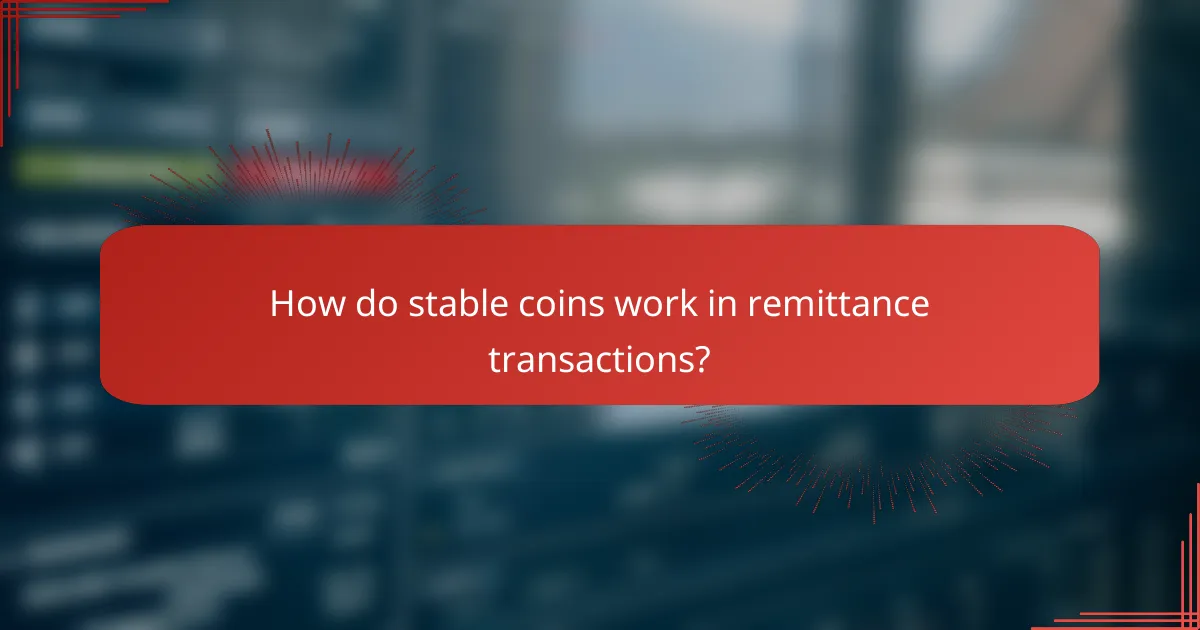
How do stable coins work in remittance transactions?
Stable coins facilitate remittance transactions by providing a digital currency that maintains a stable value, typically pegged to a fiat currency like the US dollar. This stability reduces the volatility often associated with cryptocurrencies, making them a reliable option for sending money across borders.
Blockchain technology
Stable coins operate on blockchain technology, which is a decentralized ledger that records all transactions transparently and securely. This technology allows for faster transactions, often settling in minutes, compared to traditional remittance methods that can take days.
Using blockchain also lowers transaction fees, which can be a significant advantage for migrants sending money home. Fees can range from a few cents to a couple of dollars, depending on the platform, compared to traditional services that might charge a percentage of the transaction amount.
Smart contracts
Smart contracts are self-executing contracts with the terms directly written into code. In remittance transactions, they automate the transfer of stable coins once conditions are met, such as the recipient confirming their identity.
This automation reduces the need for intermediaries, which can further lower costs and speed up the process. Migrants can benefit from this efficiency, ensuring that funds reach their families quickly and securely.
Decentralized finance (DeFi) integration
Decentralized finance (DeFi) platforms allow users to lend, borrow, and trade stable coins without traditional banking intermediaries. This integration provides migrants with additional financial services that can enhance their remittance experience.
For instance, migrants can use DeFi platforms to earn interest on their stable coins or access loans using their holdings as collateral. However, it’s essential to understand the risks involved, such as smart contract vulnerabilities and market fluctuations, before engaging with DeFi services.
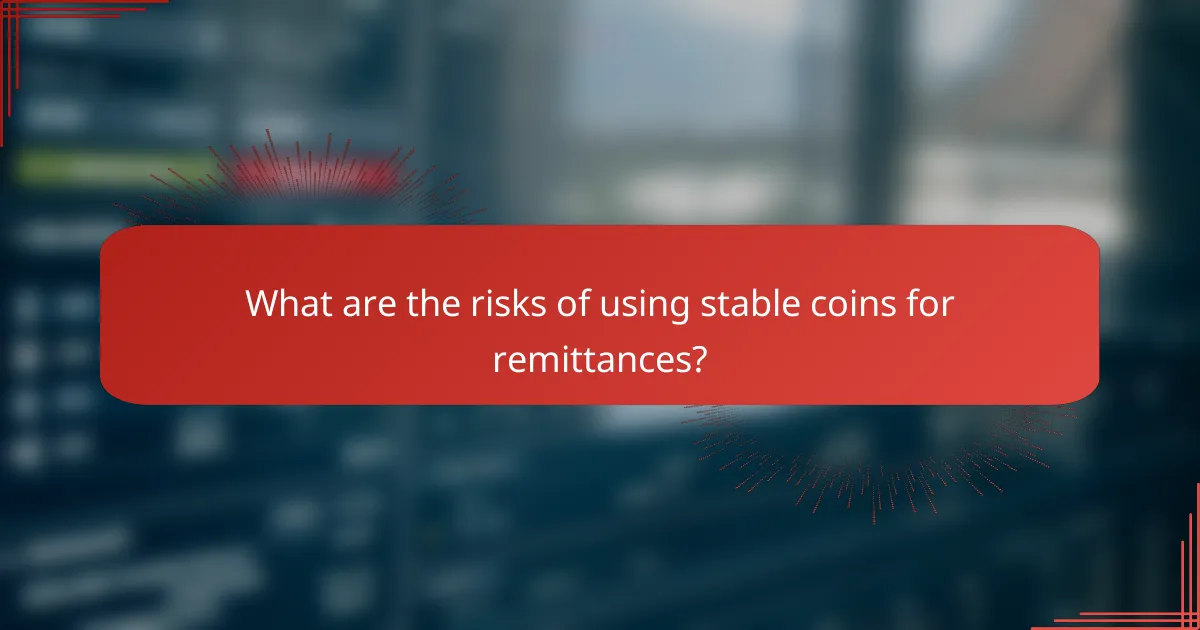
What are the risks of using stable coins for remittances?
Using stable coins for remittances carries several risks that migrants should be aware of, including regulatory concerns, market volatility, and security vulnerabilities. Understanding these risks can help individuals make informed decisions about their money transfers.
Regulatory concerns
Regulatory issues surrounding stable coins can vary significantly by country. Some jurisdictions may impose strict regulations on their use, while others may not recognize them as legal tender. Migrants should familiarize themselves with the regulations in both their home and host countries to avoid potential legal complications.
Additionally, compliance with anti-money laundering (AML) and know your customer (KYC) requirements is crucial. Failure to comply can lead to account freezes or other penalties, making it essential to choose platforms that adhere to local laws.
Volatility in certain markets
While stable coins are designed to minimize price fluctuations, they can still experience volatility in specific markets. This can occur due to changes in demand, regulatory news, or market sentiment. Migrants should monitor the stability of the stable coin they choose to ensure it maintains its peg to the underlying asset.
For instance, if a stable coin is pegged to the US dollar, fluctuations in the broader cryptocurrency market can still affect its value. It’s wise to conduct thorough research and consider using stable coins with a proven track record of stability.
Security risks
Security is a significant concern when using stable coins for remittances. Users are at risk of hacks, phishing attacks, and scams that can lead to the loss of funds. Migrants should prioritize using reputable wallets and exchanges that implement strong security measures, such as two-factor authentication and cold storage.
It’s also advisable to keep private keys secure and avoid sharing sensitive information. Regularly updating passwords and being cautious about unsolicited communications can further protect against security threats.
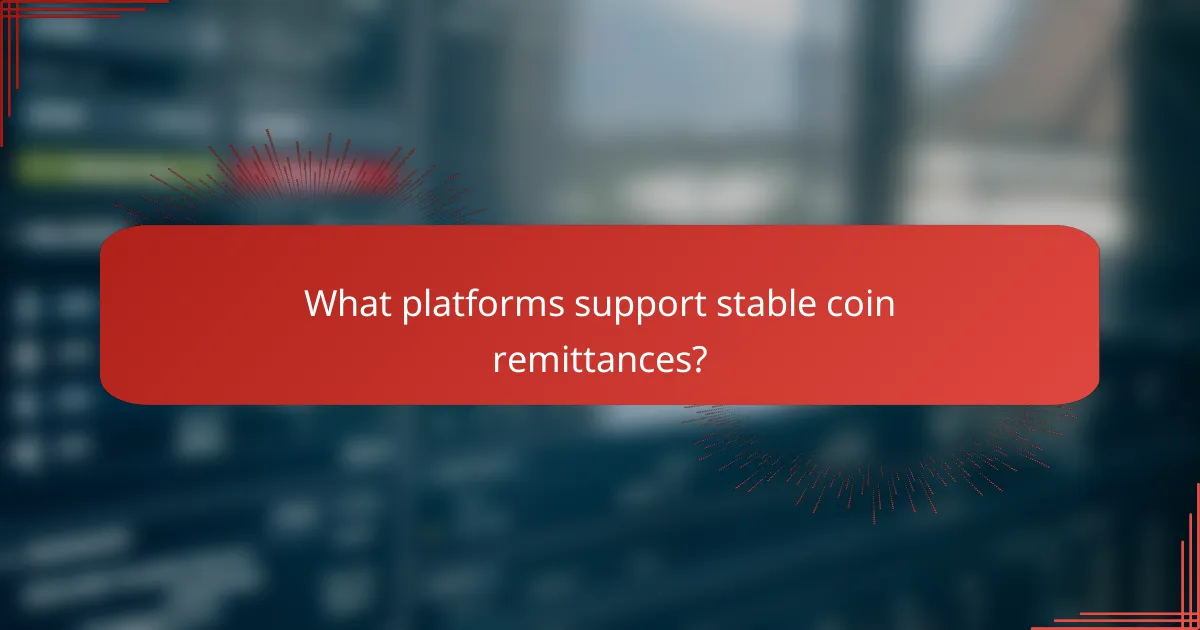
What platforms support stable coin remittances?
Several platforms facilitate stable coin remittances, allowing migrants to send money across borders efficiently and with lower fees. These platforms typically support various stable coins, providing users with options that suit their needs.
Coinbase
Coinbase is a widely recognized cryptocurrency exchange that supports stable coins like USDC. Users can easily convert their fiat currency into stable coins and send them to recipients in different countries.
To use Coinbase for remittances, create an account, verify your identity, and link your bank account or credit card. Be aware of transaction fees, which can vary based on the payment method and the amount sent.
Binance
Binance is another major platform that offers stable coin remittances, including support for Tether (USDT) and Binance USD (BUSD). It provides a user-friendly interface for trading and transferring stable coins globally.
To send money via Binance, sign up for an account, complete the necessary verification, and deposit funds. Binance typically has lower fees compared to traditional remittance services, making it an attractive option for migrants.
Remitly
Remitly specializes in remittances and has integrated stable coin options to enhance its services. It allows users to send money using stable coins directly to recipients’ bank accounts or mobile wallets.
To use Remitly, download the app, create an account, and select the stable coin option when sending money. Keep in mind that while Remitly offers competitive rates, the availability of stable coin remittances may vary by country.
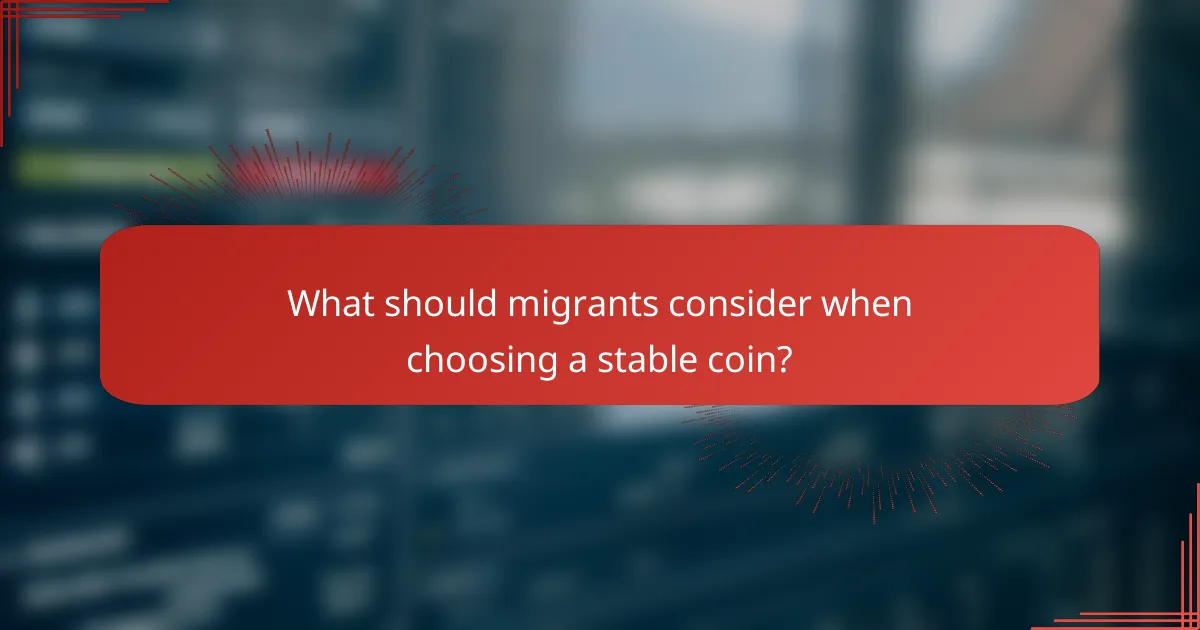
What should migrants consider when choosing a stable coin?
Migrants should evaluate several factors when selecting a stable coin for remittances, including transaction fees, exchange rates, and the stability of the underlying asset. Understanding these elements can help ensure that the chosen stable coin meets their financial needs effectively.
Transaction fees
Transaction fees are a crucial consideration when using stable coins for remittances, as they can significantly impact the total cost of sending money. Fees can vary widely depending on the stable coin, the platform used for the transaction, and the network congestion at the time of transfer.
For example, some stable coins may have low fees, often in the range of a few cents to a couple of dollars, while others might charge higher fees, especially during peak usage times. Migrants should compare the fees of different stable coins and platforms to find the most cost-effective option for their remittance needs.
Exchange rates
Exchange rates play a vital role in determining how much money the recipient will ultimately receive. When converting stable coins to local currency, fluctuations in exchange rates can lead to significant differences in the final amount received.
Migrants should look for stable coins that offer favorable exchange rates and consider using platforms that provide real-time rate comparisons. This can help them avoid losses due to unfavorable conversions and ensure that their recipients receive the maximum possible amount.
Stability of the underlying asset
The stability of the underlying asset is essential when choosing a stable coin, as it directly affects the coin’s value. Stable coins are typically pegged to fiat currencies or commodities, and their value should remain relatively constant.
Migrants should research the backing of the stable coin they are considering. Coins backed by reputable assets or organizations tend to be more reliable. It’s advisable to avoid coins with less transparency regarding their backing, as these can be more volatile and risky for remittances.


